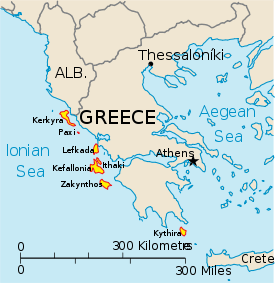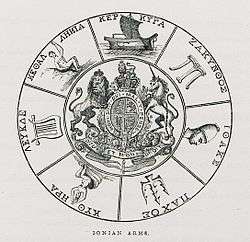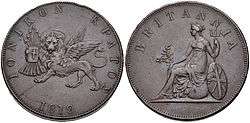United States of the Ionian Islands
The United States of the Ionian Islands (Greek: Ἡνωμένον Κράτος τῶν Ἰονίων Νήσων, romanized: Inoménon Krátos ton Ioníon Níson, lit. '"United State of the Ionian Islands"'; Italian: Stati Uniti delle Isole Ionie) was a state and amical protectorate of Great Britain between 1815 and 1864. It was the successor state of the Septinsular Republic. It covered the territory of the Ionian Islands, in modern Greece, and it was ceded to Greece as a gift of Britain to the newly enthroned King George I[7] after the Resolution for union with Greece which was proposed by the Party of the Radicals.
United States of the Ionian Islands Ηνωμένον Κράτος των Ιονίων Νήσων Stati Uniti delle Isole Ionie (it) | |||||||||
|---|---|---|---|---|---|---|---|---|---|
| 1815–1864 | |||||||||
.svg.png) Coat of arms
| |||||||||
 The Republic's territory extended to the seven main islands plus the smaller islets of the Ionian Sea | |||||||||
| Status | Amical protectorate of the Great Britain | ||||||||
| Capital | Corfu | ||||||||
| Official languages | Demotic Greek, English, Italian | ||||||||
| Common languages | Venetian | ||||||||
| Religion | Greek Orthodox | ||||||||
| Government | Federal republic | ||||||||
| Legislature | Parliament | ||||||||
| Senate (executive)b | |||||||||
| Legislative Assembly | |||||||||
| Historical era | 19th century | ||||||||
• Congress of Vienna | 9 June 1815 (signed) | ||||||||
• Protectorate est. | 9 November 1815 | ||||||||
• Constitution | 26 August 1817 | ||||||||
• Resolution for union with Greece | 26 November 1850 | ||||||||
| 29 March 1864 | |||||||||
• Union with Greece | 28 May 1864 | ||||||||
| Area | |||||||||
| 1864 | 2,659 km2 (1,027 sq mi) | ||||||||
| Population | |||||||||
• 1864 | 236,000 | ||||||||
| Currency | Obol (1818–64) | ||||||||
| |||||||||
| Today part of | Greece | ||||||||
^ Italian was used as the official language of administration during the first Parliament only.
^ The Senate is listed in the Constitution as the Executive branch of government. It shared legislative power with the Legislative Assembly, and in some British sources it appears as the Executive Council.[1][2] References: Capital city;[3] languages;[4][5] area and population.[6] | |||||||||
History
Before the French Revolutionary Wars, the Ionian Islands had been part of the Republic of Venice. When the 1797 Treaty of Campo Formio dissolved the Republic of Venice, they were annexed to the French Republic. Between 1798 and 1799, the French were driven out by a joint Russo-Ottoman force. The occupying forces founded the Septinsular Republic, which enjoyed relative independence under nominal Ottoman suzerainty and Russian control from 1800 until 1807.
The Ionian Islands were then occupied by the French after the treaty of Tilsit. In 1809, Britain defeated the French fleet off Zakynthos island on 2 October, and captured Kefalonia, Kythira, and Zakynthos. The British took Lefkada in 1810. The island of Corfu remained occupied by the French until 1814.
Under the Treaty between Great Britain and [Austria, Prussia and] Russia, respecting the Ionian Islands (signed in Paris on 5 November 1815), as one of the treaties signed during the Peace of Paris (1815), Britain obtained a protectorate over the Ionian Islands, and under Article VIII of the treaty the Austrian Empire was granted the same trading privileges with the Islands as Britain.[8] As agreed in Article IV of the treaty a "New Constitutional Charter for the State" was drawn up and was formalised with the ratification of the "Maitland constitution" on 26 August 1817, which created a federation of the seven islands, with Lieutenant-General Sir Thomas Maitland its first "Lord High Commissioner of the Ionian Islands".
A few years later resistance groups started to form. Although their energy in the early years was directed to supporting the Greeks in the revolution against the Turks, it soon started to turn towards the British. The Party of Radicals (Greek: Κόμμα των Ριζοσπαστών) founded in 1848 was against the British occupation of the Ionian Islands and in favour of union with Greece. In September 1848 there were skirmishes with the British Army in Argostoli and Lixouri on Kefalonia, which led to some relaxation in the laws and to freedom of the press. Union with Greece was now a declared aim, and by 1849, a growing restlessness resulted in even more skirmishes. The twenty-one instigators were hanged, another 34 were jailed and 87 whipped.[9]
On 26 November 1850, the Radical MP John Detoratos Typaldos proposed in the parliament the resolution for the union of the Ionian Islands with Greece which was signed by Gerasimos Livadas, Nadalis Domeneginis, George Typaldos, Frangiskos Domeneginis, Ilias Zervos Iakovatos, Iosif Momferatos, Telemachus Paizis, Ioannis Typaldos, Aggelos Sigouros-Dessyllas, Christodoulos Tofanis. Britain responded with persecutions, arrests, imprisonments, and exile. In 1862, the party was split into two factions, the United Radical Party and the Real Radical Party.
On 29 March 1864, representatives of Great Britain, Greece, France, and Russia signed the Treaty of London, pledging the transfer of sovereignty to Greece upon ratification; this was meant to bolster the reign of the newly installed King George I of Greece. Thus, on 28 May, by proclamation of the Lord High Commissioner, the Ionian Islands were united with Greece.[10]
Languages
According to the second constitution of the Republic (1803), Greek was the primary official language, in contrast to the situation in the Septinsular Republic.[11] Italian was still in use, though, mainly for official purposes since the Venetian Republic. The only island in which Italian (Venetian) had a wider spread was Cephalonia, where a great number of people had adopted Venetian Italian as their first language.[12]
States

The United States of the Ionian Islands was a federation. It included seven island states, each of which was allocated a number of seats in the parliament, the Ionian Senate:
| State | Capital | Members elected |
|---|---|---|
| Corfu | Corfu | 7 |
| Cephalonia | Argostoli | 7 |
| Cythera | Kythira | 1 or 2[13] |
| Ithaca | Vathy | 1 or 2[13] |
| Paxos | Gaios | 1 or 2[13] |
| Leucas | Lefkada | 4 |
| Zakynthos | Zakynthos | 7 |
Government

The British organised administration under the direction of a Lord High Commissioner, appointed by the British government. In total, ten men served in this capacity, including William Gladstone as a Lord High Commissioner Extraordinary (in office 1858–1859).
The Ionian Islands had a bicameral legislature, titled the "Parliament of the United States of the Ionian Islands" and composed of a Legislative Assembly and a Senate.[14]
The 1818 constitution also established a High Court of Appeal to be called the Supreme Council of Justice of the United States of the Ionian Islands, of which the president was to be known as the Chief Justice, who would rank in precedence immediately after the President of the Senate.
The successive Chief Justices were:
- John Kirkpatrick 1820–1835
- Sir James John Reid 1837–?
- Sir Charles Sargent 1860–?
- Sir Patrick MacChombaich de Colquhoun 1861–1864
See also
- List of Greek countries and regions
- List of Lord High Commissioners of the Ionian Islands
- Order of St Michael and St George, a British order of chivalry created in honour of the protectorate.
Footnotes
- Fieldhouse, David (1985). Select Documents on the Constitutional History of the British Empire and Commonwealth: "The Empire of the Bretaignes," 1175-1688. Greenwood Publishing Group. p. 679. ISBN 9780313238970.
- Fitzroy, Charles (1850). Ionian Islands. Letters by Lord C. Fitzroy and documents from other sources, on past and recent events in the Ionian Islands; shewing the anomalous political and financial condition of those States. p. 115.
- Constitution of the Ionian Islands, Article II
- Constitution of the Ionian Islands, Article IV
- Constitution of the Ionian Islands, Article V
- "Treaty of London". Greek Ministry for Foreign Affairs. Archived from the original on 8 March 2005. Retrieved 21 July 2006.
- The Times (London) 8 June 1863 p. 12 col. C
- Hammond, Richard James (1966). Portugal and Africa, 1815-1910 : a study in uneconomic imperialism. Stanford University Press. p. 2. ISBN 0-8047-0296-9.CS1 maint: ref=harv (link)
- British Occupation
- Hertslet, Edward. The map of Europe by treaty (PDF). p. 1609. Retrieved 21 July 2006.
- http://www.dircost.unito.it/cs/docs/settinsula.htm The second constitution of the Republic (1803). (in Italian)
- Kendrick, Tertius T. C. (1822). The Ionian islands: Manners and customs. J. Haldane. p. 106. Retrieved 8 February 2011.
- Cythera, Ithaca, and Paxos each elected one member, but the three elected a second member in rotation. Constitution of the Ionian Islands, Article IV
- Constitution of the Ionian Islands, Article VII
Further reading
- Gekas, Stathis (2016). Xenocracy: State, Class, and Colonialism in the Ionian Islands, 1815-1864. Berghahn Books. ISBN 9781785332623.CS1 maint: ref=harv (link)
- Hannell, David. "The Ionian Islands under the British Protectorate: social and economic problems." Journal of Modern Greek Studies 7.1 (1989): 105-132. online
- Hannell, David. "A Case of Bad Publicity: Britain and the Ionian Islands, 1848-51." European History Quarterly 17.2 (1987): 131-143.
- Knox, Bruce. "British policy and the Ionian Islands, 1847–1864: nationalism and imperial administration." English Historical Review 99.392 (1984): 503-529.
- Moschonas, Nikolaos (1975). "Τα Ιόνια Νησιά κατά την περίοδο 1797-1821" [The Ionian Islands in the period 1797-1821]. Ιστορία του Ελληνικού Έθνους, Τόμος ΙΑ′: Ο ελληνισμός υπό ξένη κυριαρχία, 1669–1821 [History of the Greek Nation, Volume XI: Hellenism under foreign rule, 1669–1821] (in Greek). Athens: Ekdotiki Athinon. pp. 382–402.CS1 maint: ref=harv (link)
- Pagratis, Gerassimos D. "The Ionian Islands under British Protection (1815–1864)." in Anglo-Saxons in the Mediterranean. Commerce, Politics and Ideas (XVII-XX Centuries), (Malta, 2007) pp: 131-150. online
- Paschalidi, Maria. "Constructing Ionian identities: the Ionian Islands in British official discourses; 1815-1864" (PhD dissertation, UCL (University College London), 2010. online
- Schumacher, Leslie Rogne. “Greek Expectations: Britain and the Ionian Islands, 1815–64.” in Imperial Expectations and Realities: El Dorados, Utopias and Dystopias, edited by Andrekos Varnava, (Manchester University Press, 2015), pp. 47–65. [www.jstor.org/stable/j.ctt1wn0scs.8 online]
External links
| Wikimedia Commons has media related to United States of the Ionian Islands. |
| Wikisource has original text related to this article: |
- "Constitution of the Ionian Islands". University of Kassel. Retrieved 21 July 2006.
- The Constitution in Italian
- "Territories of the British Empire, History of the Ionian Islands". David Rumsey Map Collection. Retrieved 2 July 2014.
